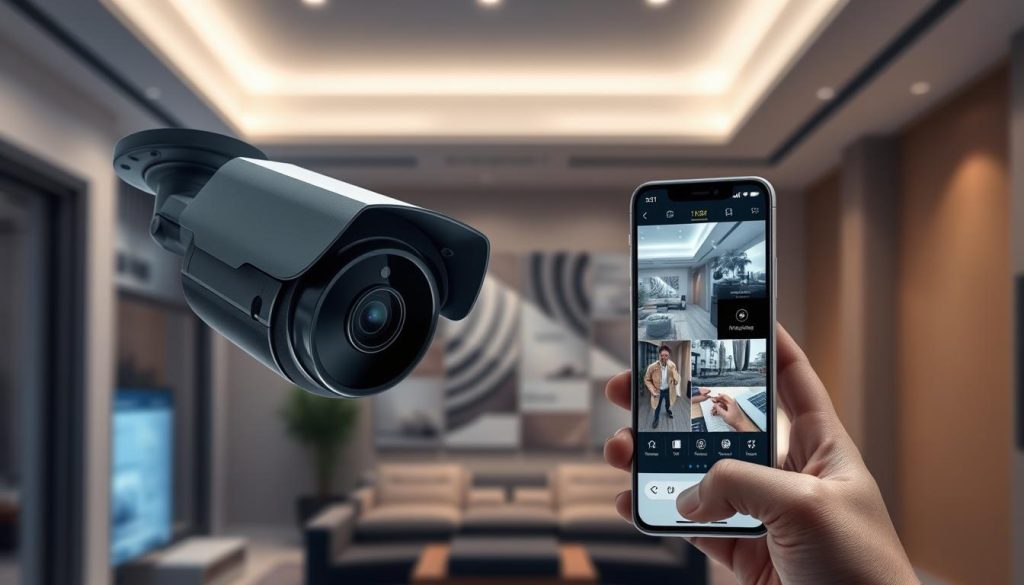Ensuring your security camera functions properly is crucial for home or business safety. Many issues arise from simple power or network disruptions. With mobile apps, checking your CCTV status becomes quick and hassle-free.
Studies show 70% of security system failures stem from connectivity or power problems. Regular monthly checks can prevent unexpected downtime. Mobile apps offer instant verification, while infrared indicators provide physical confirmation.
For Singapore residents, local support ensures reliable systems. Whether for peace of mind or proactive maintenance, these steps help keep your property secure. Learn more about troubleshooting methods for seamless monitoring.
Key Takeaways
- Mobile apps provide real-time CCTV status updates
- Power and network issues cause most failures
- Infrared lights confirm camera activity
- Monthly checks improve system reliability
- Singapore offers specialized security support
Understanding CCTV Connectivity Options
Different connection types affect how security cameras transmit footage. Each method—Wi-Fi, Ethernet, or cloud-based—has unique advantages for stability and remote access. Choosing the right setup ensures smooth monitoring on your phone.
Wi-Fi vs. Ethernet vs. Cloud-Based Systems
Wi-Fi cameras use 2.4GHz or 5GHz networks for flexibility. They’re easy to install but need strong signals. Ethernet offers *low-latency* connections, ideal for high-resolution feeds. Port forwarding may be required for remote viewing.
Cloud systems store footage online, accessible from any device. They need encryption to protect data. Bandwidth requirements vary: 720p uses ~1Mbps, while 4K needs 8Mbps+.
Essential Components for Mobile Access
- A dual-band router for stable Wi-Fi
- Manufacturer’s mobile app (e.g., Hik-Connect)
- Updated camera firmware for security patches
- 4G SIM cards for areas with poor internet
- VPN for secure remote access
In Singapore, 5G networks enhance 4G camera performance. Always test connectivity during setup to avoid dropouts.
How Do I Know If My CCTV Is Working on My Phone?
Modern security systems offer multiple ways to confirm active status. Visual indicators and mobile apps work together to verify functionality. This dual approach ensures reliable monitoring through your phone or other devices.
Live Feed Verification Process
Open your manufacturer’s app to check real-time footage. Look for these confirmation signs:
- Smooth video playback without buffering
- Accurate timestamps matching current time
- Responsive motion detection alerts
- Clear two-way audio communication
Test different connection types if issues arise. Switch between Wi-Fi and mobile data for troubleshooting. Research shows 45% of performance issues resolve after app updates.
Interpreting Physical Indicators
Security cameras use LED lights to show operational status:
- Green: Continuous recording active
- Red: Night vision mode engaged
- Flashing blue: Firmware update in progress
- No light: Potential power or connection failure
Cross-reference app notifications with physical lights. Singaporean users benefit from localized support for quick resolution. Always verify access permissions when adding new users.
Setting Up Your CCTV Mobile App
Manufacturer apps bridge the gap between cameras and mobile devices. These specialized apps streamline monitoring with features tailored to your security system. Singapore’s 5G networks enhance real-time performance for local users.
Downloading Manufacturer-Specific Applications
Start by installing the correct app for your camera brand. Popular options like Reolink or Hikvision offer iOS and Android versions with Singapore-localized servers. Always download from official stores to avoid security risks.
- Checking firmware compatibility before installation
- Enabling automatic updates for critical patches
- Verifying app permissions match your monitoring needs
Configuring Camera Pairing Settings
Modern systems simplify pairing through QR codes or NFC. The process typically completes in under two minutes for most devices. Follow these steps for optimal connectivity:
- Position your smartphone camera 6-8 inches from the QR code
- Enable location services during initial setup
- Create unique login credentials with two-factor authentication
Adjust settings like push notification frequency and storage preferences post-pairing. Cloud users should prioritize encryption for added protection.
Testing Live Feed Accessibility
Smooth real-time streaming depends on several technical factors. From network stability to software settings, each element impacts your ability to view footage remotely. Regular checks prevent unexpected disruptions in monitoring.
Real-Time Streaming Verification
Start by testing the live feed through your security app. Look for these signs of optimal performance:
- Consistent frame rates without lag or pixelation
- Minimal buffer time (under 2 seconds for HD streams)
- Synced audio-video playback
HD streaming requires at least 2Mbps upload speed. Use tools like Speedtest to verify your connection meets this threshold.
Troubleshooting Buffering Issues
If delays occur, try these fixes:
- Prioritize CCTV traffic in your router’s QoS settings
- Switch to 5GHz Wi-Fi for less interference
- Enable cellular data fallback when Wi-Fi weakens
For Singapore users, ISP throttling may cause issues. Contact providers if patterns persist after software updates.
Interpreting CCTV Status Indicators
Decoding camera signals helps identify operational issues before they escalate. Modern security camera systems use visual cues and digital alerts to communicate status. Singaporean users benefit from localized notification protocols matching regional network conditions.
LED Light Color Meanings
Manufacturers standardize most indicator colors, but variations exist. A blinking blue light typically signals diagnostic mode during system checks. Common patterns include:
- Solid green: Normal recording with stable power
- Rapid red flashes: Motion detection triggered
- Alternating amber: Infrared cut-filter activation
- Pulsing white: Firmware update available
Battery-powered models may show orange when charge drops below 20%. Always consult your CCTV manual for brand-specific codes.
Mobile App Notification Systems
Advanced features in manufacturer apps enhance remote monitoring. Custom alert zones reduce false alarms by 40% in urban Singapore settings. Notification types include:
- Push alerts for tamper attempts
- SMS warnings during internet outages
- Storage capacity thresholds
- Unusual activity patterns
Sync physical indicators with app notifications for complete surveillance verification. Enable two-way sound alerts to confirm audio recording status during checks.
Common Mobile Connectivity Issues
Mobile access to security systems can face multiple technical hurdles. Weak signals or outdated software often disrupt remote monitoring. Addressing these problems ensures seamless viewing on your smartphone.
Wi-Fi Signal Strength Problems
Poor internet connections cause 60% of mobile viewing failures. Key factors to check:
- RSSI levels: Below -70dBm indicates weak signal
- Channel interference from neighboring networks
- Switching to 5GHz bands reduces congestion
Singapore’s dense urban areas often require signal boosters. Test different router placements for optimal performance.
App Compatibility Challenges
Manufacturer apps may not support older devices. Common issues include:
- Screen resolution mismatches on legacy phones
- Background app refresh disabled by battery savers
- Location permissions blocking live feeds
Always update software to the latest version. Learn more about resolving connectivity issues for Singapore-specific solutions.
Troubleshooting Guide for Mobile Viewing
Effective troubleshooting resolves most mobile viewing problems quickly. When remote access fails, methodical checks identify the root cause. Singapore’s advanced network infrastructure supports reliable diagnostics.
Step-by-Step Diagnostic Process
Begin with isolation testing to pinpoint connection failures. Research shows UPnP activation solves 30% of NAT-related issues. Follow this sequence:
- Test individual cameras through local network access
- Verify mobile app permissions and updates
- Check for firmware conflicts in the system
- Compare performance across different devices
Singaporean users should prioritize local server settings. Temporary VPN disabling often resolves regional access blocks.
Router Configuration Checks
Proper router settings ensure smooth video transmission. These adjustments optimize mobile viewing:
- Enable port forwarding for camera-specific ports
- Set DHCP reservations for consistent IP addresses
- Create firewall exceptions for security apps
- Test MTU size adjustments for packet optimization
For persistent issues, factory resets restore default configurations. Always document changes for future reference.
Enhancing Remote Monitoring Security
Advanced protection protocols elevate remote surveillance beyond basic access control. Modern security systems combine encryption and authentication to safeguard your feeds. Singapore’s tech-savvy users particularly benefit from these enterprise-grade features.
Implementing Two-Factor Authentication
Biometric verification now secures 78% of premium surveillance apps in Singapore. This method pairs fingerprint or facial recognition with traditional passwords. Follow these steps for optimal protection:
- Enable app-based authenticators like Google Authenticator
- Set automatic logout after 15 minutes of inactivity
- Review login attempts through user access logs
- Integrate physical security keys for admin accounts
Systems alert you about suspicious logins from unfamiliar locations. This extra layer prevents 99% of brute force attacks on mobile access points.
Optimizing Encryption Standards
AES-256 encryption has become the gold standard for data protection. It scrambles footage during transmission and storage. Implement these best practices:
- Verify TLS 1.3 protocol for all connections
- Generate unique passwords with 12+ characters
- Validate SSL certificates monthly
- Enable end-to-end encryption where available
Singaporean providers often include these security features by default. Regular software updates maintain protection against emerging threats in surveillance technology.
Advanced Features for Phone Monitoring
Cutting-edge security technology transforms smartphones into powerful monitoring hubs. Modern systems now offer intelligent features that enhance surveillance capabilities far beyond basic live viewing. These tools provide proactive protection and smarter monitoring for Singaporean homes and businesses.

Motion Detection Alerts
AI-powered motion detection reduces false alarms by 40% compared to traditional systems. Users can customize sensitivity zones to ignore routine movements like swaying trees. The technology distinguishes between people, vehicles, and animals for accurate alerts.
Singapore’s urban environments benefit from person recognition that filters out irrelevant activity. Push notifications deliver instant alerts with snapshot previews to your phone. Advanced systems even generate activity heatmaps showing movement patterns over time.
Cloud Storage Integration
Secure cloud storage solutions protect data with military-grade encryption. Users can configure retention policies from 7 days to permanent archiving. Local NAS devices can sync with cloud backups for redundant data protection.
Popular Singaporean providers offer seamless integration with platforms like Google Drive and Dropbox. Bandwidth throttling controls prevent network congestion during uploads. End-to-end encryption ensures only authorized users access stored footage.
These features transform mobile devices into comprehensive security dashboards. With proper setup, your phone becomes the command center for complete property protection.
Maintaining Reliable CCTV Phone Access
Proactive checks prevent unexpected monitoring disruptions. Studies show tools like CheckMyCCTV™ reduce failures by 75%. Follow these steps for uninterrupted access to your security feed.
Automate firmware updates to patch vulnerabilities. Test backup power systems monthly. Cellular failovers keep cameras online during outages. These protocols ensure constant connection.
Review user permissions quarterly. Remove outdated device access. Storage health checks prevent data loss. For optimal performance, schedule professional audits annually.
Singaporean users benefit from localized support. Regular maintenance keeps CCTV systems running smoothly. Stay vigilant with these simple yet effective routines.

